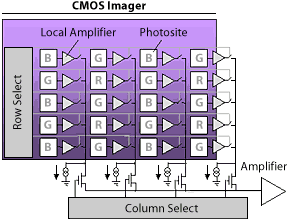CMOS
The Complementary metal oxide semiconductor (CMOS) sensor is the technology adapted by CMOS by Canon for all their DSLR (digital single lens reflex, Canon 10D, 1Ds, 1D-Mark II) as well as by Kodak for their Kodak SLR pro. Also, Kodak provides the CMOS sensors for their digital backs (Proback 645, to be discontinued). The structure of the sensor is quite different from the CCD technology. Each photosite is a photdiode converting directly the light into electric signals. An amplifier can be direcly incorporated on the sensor with the photosite (figure 4). This means that each photosite can behave like an autonomous entity and that just a small portion of the sensor or just a single pixel can be read out (the "windowing"). Another advantage is to turn off the sites which collect too much light and to prevent the overexposure to neighboring sites (the "antiblooming" feature).
 |
Figure 4: The CMOS sensor converts the light intensity at the photosite and most functions are integrated on the chip. The readout can be done from any section and each photosite can be turned on/off independantly. |
Overlaying the entire sensore a grid of metal interconnects to apply timing and readout signals. The main advantage of the CMOS sensor is the integration of additional circuitry on chip with the same fabrication process. This integration allows a low power consumation.
Comparison CCD vs CMOS
| Feature | CCD | CMOS |
| Signal out of the photosite | Voltage | Pixels |
| Sensitivity | High | High |
| Speed | Moderate | High |
| Windowing | No | Yes |
| Antiblooming | None-moderate | High |
| Sensor complexity | None | High |
| System complexity | High | Low |
| Signal to noise | Low-moderate | High |
| Energy need | High | Low |
| Dynamic range | High | Moderate |
| Uniformity | High | Low-moderate |